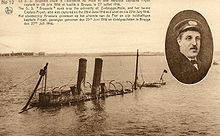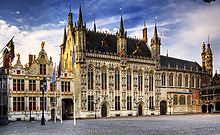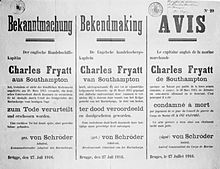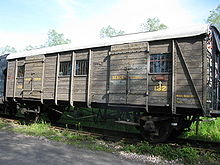- Charles Fryatt
-
Charles Algernon Fryatt 
Charles FryattBorn 2 December 1872
Southampton, HampshireDied 27 July 1916 (aged 43)
Bruges, BelgiumNationality English Occupation Merchant Navy Captain Employer Great Eastern Railway Known for Attempting to ram U-33 during the First World War and being executed for that act. Spouse Ethel Children Olive
Victoria
Doris
Vera
Mabel
Charles
DorothyAwards Order of Leopold (posthumous)
Belgian Maritime War Cross (posthumous)Charles Algernon Fryatt (2 December 1872 – 27 July 1916) was a British mariner who attempted to ram a German U-boat in 1915. His ship, the SS Brussels was captured by the Germans in 1916. When it became clear who he was, Fryatt was court-martialled and executed, although he was a civilian. There was international outrage following his execution. In 1919, his body was exhumed and given a funeral with full honours in the United Kingdom.
Contents
Early life
Fryatt was born on 2 December 1872 in Southampton, the son of Charles and Mary Fryatt.[1][2] He attended Freemantle School in the late 1870s.[3] In 1881, Fryatt's family lived at 22 Trinity Terrace, in St Mary's, Southampton,[4] but later moved to Harwich, Essex where he attended the Corporation School.[1] He and his wife, Ethel,[2] had seven children; six girls and one boy.[5] The children were Olive, Victoria, Doris, Vera, Mabel, Charles and Dorothy.[1] The younger Charles later followed his father into the merchant navy, training at HMS Worcester.[6]
Career
On leaving school, Fryatt entered the Mercantile Marine, serving on SS County Antrim, SS Ellenbank, SS Marmion and SS Harrogate. In 1892, Fryatt joined the Great Eastern Railway as a seaman on Great Central Railway ship,[7] was attacked by a German U-Boat. The ship was chased for 40 nautical miles (74 km). With deckhands assisting the stokers, the ship made 16 knots (30 km/h) when it would normally have been pushed to make 14 knots (26 km/h). Wrexham arrived at Rotterdam with burnt funnels. The Great Eastern Railway presented him with a gold watch for this feat. The watch was inscribed Presented to Captain C. A. Fryatt by the Chairman and Directors of the G.E Railway Company as a mark of their appreciation of his courage and skilful seamanship on March 2nd, 1915. Later that month he was in charge of Colchester when it was unsuccessfully attacked by a U-boat.[1]
On 28 March, he was ordered to stop by U-33 when his ship was near the Maas lightvessel.[8] Seeing the U-boat had surfaced in order to torpedo SS Brussels, Fryatt ordered full steam ahead and proceeded to try and ram U-33, which was forced to crash dive.[9] This action was in compliance of orders issued by Winston Churchill to captains of merchant ships. These orders included treating the crews of U-boats as felons and not as prisoners of war. White flags were to be ignored. Churchill's order also stated that survivors from U-boats may be shot if this was more convenient than taking them prisoner. If a captain was to surrender his ship he would be prosecuted by the British. The Germans were aware of these orders, having found a copy of them when they captured Admiralty.[9] The watch was inscribed Presented by the Lords Commissioners of the Admiralty to Chas. Algernon Fryatt Master of the S.S. 'Brussels' in recognition of the example set by that vessel when attacked by a German submarine on March 28th, 1915. Fryatt was presented with a certificate on vellum by the Lords Commissioners of the Admiralty. He was also praised in the House of Commons.[1][10]
Capture
On 25 June 1916, Brussels left Hoek van Holland bound for Harwich.[1] Lights were shown from the beach and a flare was fired.[11] A passenger is reported to have remained on deck and signalled to shore.[12] Five German destroyers surrounded Brussels. The passengers were told to prepare to take to the lifeboats and orders were given for official papers to be destroyed, which was done successfully. Brussels was taken by the Germans, and the radio was destroyed. Firstly, she was escorted into Zeebrugge and then to Bruges.[11]
Court Martial
Fryatt and his crew were interned at Ruhleben. On 16 July, it was reported in De Telegraaf that Fryatt had been charged with sinking a German submarine.[1] The Germans knew that U-33 had not been sunk. At the time of the trial she was on active service as part of the Constantinople Flotilla.[13] The basis for the charge was the inscriptions on his watches.[1] Fryatt was tried at a Court Martial on 27 July.[9] The Court Martial was held at Bruges Town Hall.[11] He was found guilty of being a franc-tireur and sentenced to death. The sentence was confirmed by the Kaiser.[9] At 19:00, Fryatt was executed by firing squad.[11] He was buried in a small cemetery just outside Bruges which the Germans used for burying Belgian "traitors".[9] The grave was later visited by diplomat Sir Walter Townley and his wife.[11] Townley was the British Ambassador to the Netherlands from 1917 to 1919.[14]
An execution notice was published in Dutch, French and German announcing the death of Fryatt. It was signed by Admiral Ludwig von Schröder. A translation of the execution notice reads as follows:[11]
NOTICE. The English captain of the Mercantile Marine, Charles Fryatt, of Southampton, though he did not belong to the armed forces of the enemy, attempted on March 28th, 1915, to destroy a German submarine by running it down. This is the reason why he has been condemned to death by judgment this day of the War Council of the Marine Corps and has been executed. A perverse action has thus received its punishment, tardy but just. Signed VON SCHRODER, Admiral Commandant of the Corps de Marine, Bruges, July 27th, 1916.German post-war confirmation of Court Martial
A German International Law Commission[15] named after its chairman Walther Schücking "Schücking Commission" confirmed the sentence on 2 April 1919:[16]
"The execution by shooting of Captain Charles Fryatt, which was given by the Court Martial Bruges, due to the sentence of the court martial proceedings on 27 July 1916, contains no violation of international law, The Commission apologizes most vividly for the hurry in which the judgment was enforced."The Commission was heavily criticised in Germany for the second sentence. The Commission's members Eduard Bernstein and Oskar Cohn dissented: In their opinion it was a severe infringement of international law.[17]
Reaction
On 31 July 1916, British Prime Minister H. H. Asquith issued a statement in the House of Commons.[1]
I deeply regret to say that it appears to be true that Captain Fryatt has been murdered by the Germans. His Majesty's Government have heard with the utmost indignation of this atrocious crime against the laws of nations and the usages of war. Coming as it does contemporaneously with the lawless cruelty towards the population of Lille and other occupied districts of France, it shews that the German High Command, under the stress of military defeat, have renewed their policy of terrorism. It is impossible of course to conjecture to what atrocities they may proceed. His Majesty's Government desire to repeat emphatically their resolve that such crimes shall not, if they can help it, go unpunished. When the time arrives they are determined to bring to justice the criminals whoever they maybe and whatever position they may occupy. In such cases as these the authors of the system under which such crimes are committed may well be the most guilty of all. The question of what immediate action can be taken is engaging the earnest attention of the Government and I hope very soon to announce to the House of Commons what we can do.Lord Claud Hamilton, MP, Chairman of the Great Eastern Railway, denounced the execution as "sheer, brutal murder". The Mayor of Harwich opened a fund to erect a permanent memorial to Fryatt. A similar fund was opened in the Netherlands.[1]
In the United States, The New York Times denounced the execution as "a deliberate murder". The New York Herald called it "The crowning German atrocity". In the Netherlands, the Nieuwe Rotterdamsche Courant described the execution as "arbitrary and unjust", while the Handelsblad Holland called it "A cowardly murder inspired by hatred and revenge".[1] In Switzerland, the Journal de Genève said "It is monstrous to maintain that armed forces have a right to murder civilians but that civilians are guilty of a crime in defending themselves".[18] The Dutch branch of the League of Neutral States presented the Great Eastern Railway a memorial tablet which was erected at Liverpool Street station.[8] The memorial was unveiled on 27 July 1917, exactly a year after Fryatt's execution.[19] The scrap value of Brussels was donated towards the cost.
The Great Eastern Railway awarded Fryatt's widow a pension of £250 per annum. The Government granted her an extra £100 per annum pension on top of her entitlement. Fryatt's insurers, the Provident Clerk's Association, paid the £300 that Mrs Fryatt was entitled to immediately, dispensing with the usual formalities. The Royal Merchant Seaman's Orphanage offered to educate two of Fryatt's seven children. The King expressed his indignation and abhorrence at the execution of Fryatt in a letter to Mrs Fryatt.[1] In the letter, he also wrote "The action of Captain Fryatt in defending his ship against the attack of an enemy submarine was a noble instance of the resource and self-reliance so characteristic of his profession."[18]
Funeral
In 1919, Fryatt's body was exhumed and returned to the United Kingdom for burial.[20] His coffin was landed at Dover, and transported in South Eastern and Chatham Railway PMV No.132 to London.[21] On 8 July, his funeral was held at St Paul's Cathedral. Hundreds of merchant seamen and widows of merchant seamen and fishermen attended. Representing the Government were many members of the Admiralty, the Board of Trade, the Cabinet and the War Office.[20]
The band of the Great Eastern Railway, augmented by drummers from the Royal Marines played the Dead March. Eternal Father, Strong to Save and Abide with Me were sung, and a blessing given by the Bishop of London. The route of the coffin to Liverpool Street station was lined with people.[20] Fryatt was buried at All Saint's Church, Upper Dovercourt. His coffin was carried from the station to the church on a gun carriage.[22] His widow was presented with the insignia of the Belgian Order of Leopold which had been posthumously awarded to Fryatt.[23] Fryatt was posthumously awarded the Belgian Maritime War Cross.[24]
Namesakes
A wing at Dovercourt Cottage Hospital - which is now known as the Captain Fryatt Memorial Hospital.[25] - was named in Fryatt's honour.[26] A public house in nearby Parkeston is also named in Captain Fryatt's honour.[27]
In Canada, the 11,027 feet (3,361 m) high Mount Fryatt (52°33′00″N 117°54′35″W / 52.55°N 117.90972°W) was named in 1921 in honour of Captain Fryatt.[28] The 10,317 feet (3,145 m) high Brussels Peak (51°31′00″N 117°49′20″W / 51.5166667°N 117.82222°W) was named in honour of his ship.[29]
See also
References
- ^ a b c d e f g h i j k l m Great Eastern Railway Magazine, September 1916, p216-28
- ^ a b "Debt of Honour Register". Commonwealth War Graves Commission. http://www.cwgc.org/debt_of_honour.asp. Retrieved 19 December 2009.
- ^ "Fryatt Plaque Installation". Freemantle CE School & Community Care College. http://www.freemantle.southampton.sch.uk/school/Fryatt.htm. Retrieved 8 December 2009.
- ^ "1881 Census of the United Kingdom". The National Archives. http://www.nationalarchives.gov.uk/records/census-records.htm. Retrieved 19 December 2009.
- ^ Barton, George (2008). Celebrated Spies and Famous Mysteries of the Great War. BiblioBazaar. p. 115. ISBN 9780559708299.
- ^ "School Speech Days. Lord Inchcape In H.M.S. Worcester" (News). The Times (London). Friday, 29 July 1927. Issue 44646, col D, p. 14.
- ^ "Great Central Railway postcard of SS Wrexham leaving Grimsby Docks". Simplon Postcards. http://www.simplonpc.co.uk/LNER_GCR1.html#anchor1598515. Retrieved 22 September 2010.
- ^ a b Great Eastern Railway Magazine, November 1917, p248
- ^ a b c d e "Captain Charles Fryatt". Great War Primary Documents Archive. http://www.gwpda.org/naval/pers0003.htm. Retrieved 8 December 2009.
- ^ "House of Commons Hansard; vol. 71, col. 698". Hansard. London: Parliament of the United Kingdom. 28 April 1915. http://hansard.millbanksystems.com/commons/1915/apr/28/german-submarines-captains-of-escaped#S5CV0071P0_19150428_HOC_43. Retrieved 19 December 2009.
- ^ a b c d e f Great Eastern Railway Magazine October 1918, p189-90
- ^ New York Times, 29 July 1916
- ^ "U 33". Uboat. http://www.uboat.net/wwi/boats/index.html?boat=33. Retrieved 19 December 2009.
- ^ "Previous Ambassadors". Foreign & Commonwealth Office. http://ukinnl.fco.gov.uk/en/about-us/our-embassy-in-hague/our-ambassador/previous-ambassadors. Retrieved 18 September 2010.
- ^ Regulation of the Council of the People's Deputies on the composition and proceedings of the commission investigating the charges of violation of international law in the treatment of prisoners of war in Germany, 30 November 1918, Reichsgesetzblatt. p. 1388
- ^ Mende,"Der Fall Fryatt (The case Fryatt)", Deutsche Juristen-Zeitung, volume 24, (1919), p. 419
- ^ "Zum Fall Fryatt",Deutsche Allgemeine Zeitung, 3 May 1919
- ^ a b "British Government Statement on the Execution of Captain Fryatt, August 1916". First World War. http://www.firstworldwar.com/source/fryatt_britishgovt.htm. Retrieved 10 December 2009.
- ^ "Remembering The Great War, London Part Two". Ray Westlake. http://www.hellfire-corner.demon.co.uk/westlakelondontwo.htm. Retrieved 10 December 2009.
- ^ a b c New York Times 9 July 1919
- ^ "Bid to save WWI heroes' carriage". BBC News Online. 3 December 2009. http://news.bbc.co.uk/1/hi/england/8393192.stm. Retrieved 10 December 2009.
- ^ "Fryatts funeral". Brian Woods. http://www.123freehost.co.uk/sites/harwichmem-web/default.asp. Retrieved 10 December 2009.
- ^ Verity, Liza (2004). "Fryatt, Charles Algernon (1871–1916)". Oxford Dictionary of National Biography. Oxford University Press. doi:10.1093/ref:odnb/33288. http://www.oxforddnb.com/view/article/33288. Retrieved 10 December 2009. Subscription or UK public library membership required
- ^ The Great Eastern Magazine July 1920, p6
- ^ "Service to mark war hero's death". East Anglian Daily Times. http://www.eadt.co.uk/content/eadt/news/story.aspx?brand=EADOnline&category=News&tBrand=EADOnline&tCategory=zNews&itemid=IPED09+Jul+2006+16%3A46%3A27%3A167. Retrieved 10 December 2009.
- ^ Great Eastern Railway Magazine, January 1917, p26
- ^ "Captain Fryatt, Harwich, Essex". UKPubFinder. http://www.ukpubfinder.com/pub/24164. Retrieved 27 April 2010.
- ^ "Mount Fryatt". Peakfinder. http://www.peakfinder.com/peakfinder.ASP?PeakName=Mount+Fryatt. Retrieved 10 December 2009.
- ^ "Brussels Peak". Peakfinder. http://www.peakfinder.com/peakfinder.ASP?PeakName=brussels+peak. Retrieved 10 December 2009.
External links
Categories:- 1916 deaths
- English sailors
- British Merchant Navy personnel
- Military discipline and World War I
- Executed British people
- People executed by firing squad
- 1872 births
- People of the Great Eastern Railway
- People executed by the German Empire
- Civilians killed in World War I
- People from Southampton
- People from Harwich
- Order of Leopold recipients
Wikimedia Foundation. 2010.






